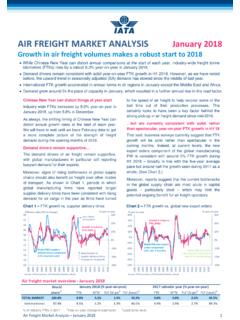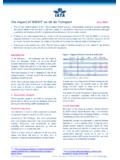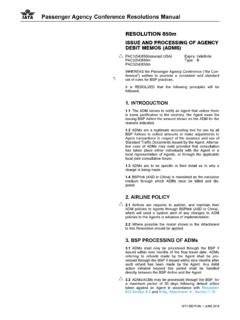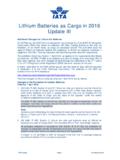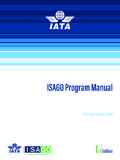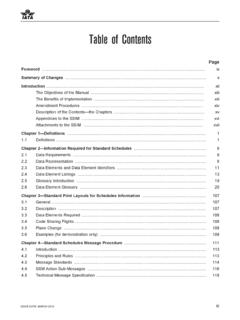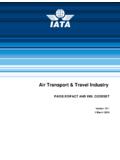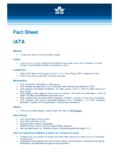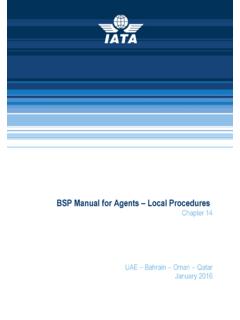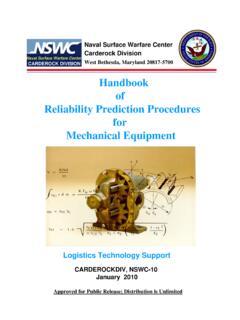Transcription of Airlines’ Accounting Policies on Aircraft Depreciation and ...
1 Airlines Accounting Policies on Aircraft Depreciation and Maintenance Capitalization - February 2012 1 Airlines Accounting Policies on Aircraft Depreciation and Maintenance Capitalization An Exclusive Benchmark Analysis by IATA s Maintenance Cost Task Force MCTF - February 2012 Airlines Accounting Policies on Aircraft Depreciation and Maintenance Capitalization - February 2012 2 NOTICE DISCLAIMER. The information contained in this publication is subject to constant review in the light of changing government requirements and regula-tions.
2 No subscriber or other reader should act on the basis of any such information without referring to applicable laws and regulations and/or without taking appropriate professional advice. Although every effort has been made to ensure accuracy, the International Air Transport Association shall not be held responsible for any loss or damage caused by errors, omissions, misprints or misinterpretation of the contents hereof. Furthermore, the International Air Transport Association expressly disclaims any and all liability to any person or entity, whether a purchaser of this publication or not, in respect of anything done or omitted, and the consequences of anything done or omitted, by any such person or entity in reliance on the contents of this publication.
3 International Air Transport Association. All Rights Reserved. No part of this publication may be repro-duced, recast, reformatted or transmitted in any form by any means, electronic or mechanical, in-cluding photocopying, recording or any information storage and retrieval system, without the prior writ-ten permission from: Senior Vice President Safety, Operations and Infrastructure International Air Transport Association 800 Place Victoria Box 113 Montreal, Quebec CANADA H4Z 1M1 Airlines Accounting Policies on Aircraft Depreciation and Maintenance Capitalization - February 2012 3 DEFINITIONS & ACRONYMS A/C: Aircraft APU: Auxiliary Power Unit ASPAC: Asia South Pacific ESV: Engine Shop Visit LG: Landing Gear LLP: Life Limited part MCTF: Maintenance Cost Task Force MENA: Middle East North Africa MR: Maintenance Reserves MTBR: Mean Time Between Removals NB.
4 Narrow-body Aircraft with more than 100 seats (excludes Embraer 190/195) NRV: Net Realizable Value RJ: Regional-jets up to 100 seats (includes Embraer 190/195) SV: Shop Visit TP: Turbo-props TR: Thrust Reverser WB: Wide-body Aircraft with more than one aisle or equivalent freighter TABLE OF CONTENT Definitions & Acronyms p 3 1. Introduction p 4 2. Aircraft Depreciation p 5 Airframe p 6 Engines p 8 Components and spare Parts / Inventory p 10 3. Maintenance Capitalization p 11 Airframe p 12 Engines p 13 Large Components Repairs p 13 Modifications p 14 4.
5 Conclusion p 14 Annexes p 15 Annex 1: List of participating airlines p 15 IATA s Maintenance Cost Task Force (MCTF) p 16 This article provides information about some airline Accounting practices from a practitioner s perspective. For the official Accounting Policies of airlines around the world, each airline s Fi-nancial Reporting/ Accounting and Investor Relations Department should be contacted as well as experts in Accounting firms working on the specific subject. Airlines Accounting Policies on Aircraft Depreciation and Maintenance Capitalization - February 2012 4 1.
6 INTRODUCTION The objective of this survey is to provide benchmark information and best practices regarding airlines' Accounting Policies for Aircraft Depreciation and maintenance capitalization. For proper Accounting treatment (financial re-porting to governments, shareholders, etc.), an airline should seek expert accountant assistance. METHODOLOGY IATA conducted a survey on Airline Aircraft Depreciation and Maintenance Capitalization . This survey took place from June to October 2011. 50 air-lines participated, representing over Aircraft (25% of world s fleet).
7 Fleet sizes ranged from less than 10 to more than 700 active Aircraft *. Aircraft Depreciation was divided in two areas: Aircraft as a whole Airframe, Engines, LLP, rotables and consumables (for the airlines that depreciate airframe and certain high value components separately) Maintenance capitalization covered events such as heavy checks, engine shop visits, component maintenance and modifications. Africa8%S. America10%N. America8%ASPAC18%China6%Europe40%MENA10% Africa2%S. America30%N. America7%ASPAC18%China7%Europe30%MENA6%0 -15 A/C6%16-30 A/C26%31-70 A/C30%71-150 A/C20%151+ A/C18%Figure 1: Individual Airlines by Region Figure 2: Active Fleet by Region Figure 3: Active fleet size *Source: ACAS3 - Update July 2011 Airlines Accounting Policies on Aircraft Depreciation and Maintenance Capitalization - February 2012 5 2.
8 Aircraft Depreciation Depreciation is a non-cash expense that is reported in a company s financial statements. Depreciation reduces the net book value of the asset as a result of wear and tear, age (deterioration) or obsolescence. Because it is a non-cash expense, Depreciation lowers the company s reported earnings. Depreciation is an exercise in cost allocation under-taken to match the cost of assets to the revenues earned during the periods the assets are used. Reduction of annual Depreciation amounts results to reporting higher net income or reduced losses; these results are linked to many airline decisions regarding shareholders, manage-ment, unions etc.
9 Aircraft Depreciation is a large airline expense and reflects the decrease of the value of the asset ( Aircraft ) or the allocation of costs to replace the Aircraft when time is due. Both decrease of value and allocation of costs are depicted on an annual basis. The survey asked airlines to provide information on the major items re-lated to Depreciation treatment: the cost of the asset/ Aircraft (assumed at 100%), the expected salvage value (as % of acquisition value), also known as the residual value of the asset, the estimated useful life of the asset, and the method of apportioning the cost over such life ( Depreciation method) It should be noted that Depreciation is not an attempt to measure the current value of the Aircraft .
10 Current (market) value is determined by market conditions (agreement on price between seller and buyer). Many factors are considered when estimating the economic life and residual value of a commercial Aircraft . These factors include but are not limited to: physical or economic life, corporate strategy, planned use, expected technological changes, Aircraft /fleet replacement policy etc. Depreciation practices have changed as flight equipment and industry conditions have changed. In general, the fleet replacement cycle has lengthened; production and delivery backlogs have played a role as well as any profitability targets set by the airline s management.
